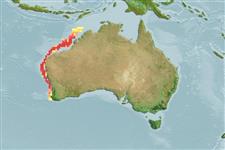Elasmobranchii (sharks and rays) >
Carcharhiniformes (Ground sharks) >
Triakidae (Houndsharks) > Triakinae
Etymology: Mustelus: Latin for weasel, an ancient name for sharks, possibly referring to the pointed snouts, swift movements and/or rapacious feeding behavior of smaller predatory sharks [strictly not tautonymous with Squalus mustelus Linnaeus 1758 since type was designated by the ICZN] (See ETYFish); ravidus: Latin for grayish, referring to its pale-gray dorsal coloration (See ETYFish).
More on authors: White & Last.
Environment: milieu / climate zone / depth range / distribution range
Ecology
Marine; benthopelagic; depth range 106 - 300 m (Ref. 72460). Tropical, 116°E - 119°E
Eastern Indian Ocean: Western Australia.
Size / Weight / Age
Maturity: Lm ? range ? - ? cm
Max length : 68.3 cm TL male/unsexed; (Ref. 72460); 78.8 cm TL (female)
Short description
Identification keys | Morphology | Morphometrics
This species is moderately-sized with the following set of characters: high preanal length to anal-caudal space (9.6-10.5), to dorsal-caudal space (6.1-6.8) ratios; dorsal fins are large, slightly raked back, base length of first dorsal fin (0.8-1) times anal-caudal space; claspers of adult males are relatively long with outer length about 10% TL, terminating only slightly short of anal fin origin; teeth in about 77/73 rows, exposed to a greater extent around symphysis of lower jaw when mouth closed; 90-91 precaudal vertebral centra; 35-37 monospondylous centra; narrow white tip and thin pale margin on first dorsal fin, distinct dusky tip on second
dorsal fin and distinct black tip on terminal caudal lobe (Ref. 72460).
Life cycle and mating behavior
Maturity | Reproduction | Spawning | Eggs | Fecundity | Larvae
White, W.T. and P.R. Last, 2006. Description of two new species of smooth-hounds, Mustelus widodoi and M. ravidus (Carcharhiniformes: Triakidae) from the western central Pacific. Cybium 30(3):235-246. (Ref. 72460)
IUCN Red List Status (Ref. 130435: Version 2024-1)
Threat to humans
Harmless
Human uses
Tools
Special reports
Download XML
Internet sources
Estimates based on models
Preferred temperature (Ref.
123201): 14.4 - 22.1, mean 19.9 °C (based on 22 cells).
Phylogenetic diversity index (Ref.
82804): PD
50 = 0.5000 [Uniqueness, from 0.5 = low to 2.0 = high].
Bayesian length-weight: a=0.00224 (0.00104 - 0.00482), b=3.14 (2.97 - 3.31), in cm total length, based on LWR estimates for this Genus-body shape (Ref.
93245).
Trophic level (Ref.
69278): 3.6 ±0.4 se; based on size and trophs of closest relatives
Resilience (Ref.
120179): Low, minimum population doubling time 4.5 - 14 years (Preliminary low fecundity).
Fishing Vulnerability (Ref.
59153): Moderate to high vulnerability (52 of 100).
